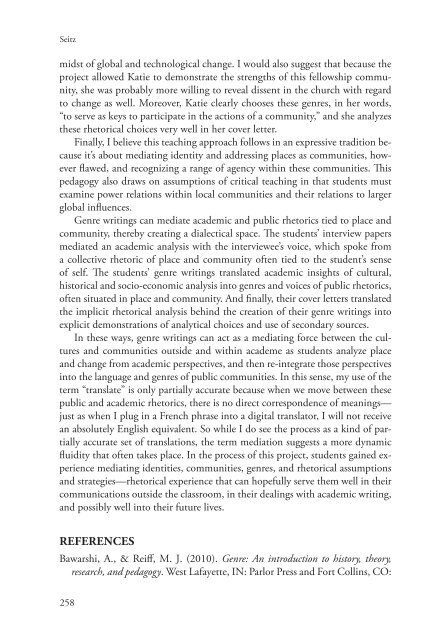Critical Expressivism- Theory and Practice in the Composition Classroom, 2014a
Critical Expressivism- Theory and Practice in the Composition Classroom, 2014a
Critical Expressivism- Theory and Practice in the Composition Classroom, 2014a
You also want an ePaper? Increase the reach of your titles
YUMPU automatically turns print PDFs into web optimized ePapers that Google loves.
Seitz<br />
midst of global <strong>and</strong> technological change. I would also suggest that because <strong>the</strong><br />
project allowed Katie to demonstrate <strong>the</strong> strengths of this fellowship community,<br />
she was probably more will<strong>in</strong>g to reveal dissent <strong>in</strong> <strong>the</strong> church with regard<br />
to change as well. Moreover, Katie clearly chooses <strong>the</strong>se genres, <strong>in</strong> her words,<br />
“to serve as keys to participate <strong>in</strong> <strong>the</strong> actions of a community,” <strong>and</strong> she analyzes<br />
<strong>the</strong>se rhetorical choices very well <strong>in</strong> her cover letter.<br />
F<strong>in</strong>ally, I believe this teach<strong>in</strong>g approach follows <strong>in</strong> an expressive tradition because<br />
it’s about mediat<strong>in</strong>g identity <strong>and</strong> address<strong>in</strong>g places as communities, however<br />
flawed, <strong>and</strong> recogniz<strong>in</strong>g a range of agency with<strong>in</strong> <strong>the</strong>se communities. This<br />
pedagogy also draws on assumptions of critical teach<strong>in</strong>g <strong>in</strong> that students must<br />
exam<strong>in</strong>e power relations with<strong>in</strong> local communities <strong>and</strong> <strong>the</strong>ir relations to larger<br />
global <strong>in</strong>fluences.<br />
Genre writ<strong>in</strong>gs can mediate academic <strong>and</strong> public rhetorics tied to place <strong>and</strong><br />
community, <strong>the</strong>reby creat<strong>in</strong>g a dialectical space. The students’ <strong>in</strong>terview papers<br />
mediated an academic analysis with <strong>the</strong> <strong>in</strong>terviewee’s voice, which spoke from<br />
a collective rhetoric of place <strong>and</strong> community often tied to <strong>the</strong> student’s sense<br />
of self. The students’ genre writ<strong>in</strong>gs translated academic <strong>in</strong>sights of cultural,<br />
historical <strong>and</strong> socio-economic analysis <strong>in</strong>to genres <strong>and</strong> voices of public rhetorics,<br />
often situated <strong>in</strong> place <strong>and</strong> community. And f<strong>in</strong>ally, <strong>the</strong>ir cover letters translated<br />
<strong>the</strong> implicit rhetorical analysis beh<strong>in</strong>d <strong>the</strong> creation of <strong>the</strong>ir genre writ<strong>in</strong>gs <strong>in</strong>to<br />
explicit demonstrations of analytical choices <strong>and</strong> use of secondary sources.<br />
In <strong>the</strong>se ways, genre writ<strong>in</strong>gs can act as a mediat<strong>in</strong>g force between <strong>the</strong> cultures<br />
<strong>and</strong> communities outside <strong>and</strong> with<strong>in</strong> academe as students analyze place<br />
<strong>and</strong> change from academic perspectives, <strong>and</strong> <strong>the</strong>n re-<strong>in</strong>tegrate those perspectives<br />
<strong>in</strong>to <strong>the</strong> language <strong>and</strong> genres of public communities. In this sense, my use of <strong>the</strong><br />
term “translate” is only partially accurate because when we move between <strong>the</strong>se<br />
public <strong>and</strong> academic rhetorics, <strong>the</strong>re is no direct correspondence of mean<strong>in</strong>gs—<br />
just as when I plug <strong>in</strong> a French phrase <strong>in</strong>to a digital translator, I will not receive<br />
an absolutely English equivalent. So while I do see <strong>the</strong> process as a k<strong>in</strong>d of partially<br />
accurate set of translations, <strong>the</strong> term mediation suggests a more dynamic<br />
fluidity that often takes place. In <strong>the</strong> process of this project, students ga<strong>in</strong>ed experience<br />
mediat<strong>in</strong>g identities, communities, genres, <strong>and</strong> rhetorical assumptions<br />
<strong>and</strong> strategies—rhetorical experience that can hopefully serve <strong>the</strong>m well <strong>in</strong> <strong>the</strong>ir<br />
communications outside <strong>the</strong> classroom, <strong>in</strong> <strong>the</strong>ir deal<strong>in</strong>gs with academic writ<strong>in</strong>g,<br />
<strong>and</strong> possibly well <strong>in</strong>to <strong>the</strong>ir future lives.<br />
REFERENCES<br />
Bawarshi, A., & Reiff, M. J. (2010). Genre: An <strong>in</strong>troduction to history, <strong>the</strong>ory,<br />
research, <strong>and</strong> pedagogy. West Lafayette, IN: Parlor Press <strong>and</strong> Fort Coll<strong>in</strong>s, CO:<br />
258


















